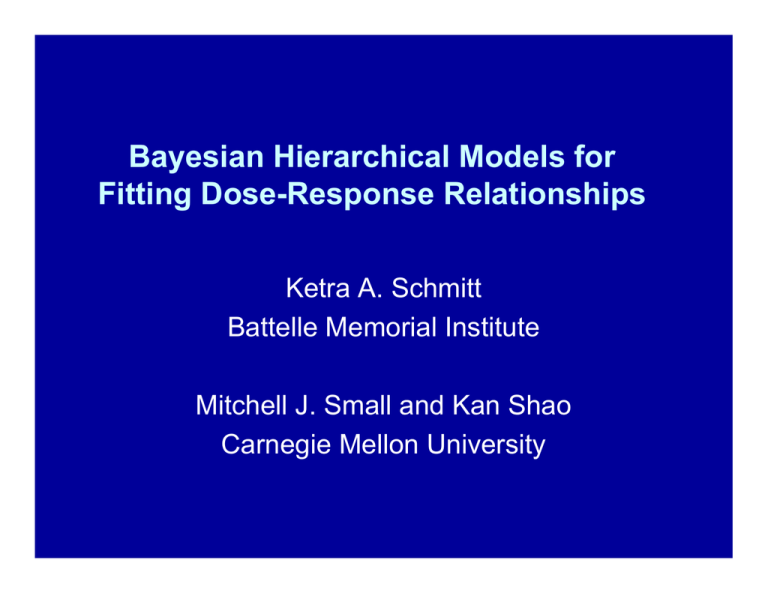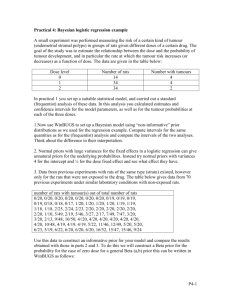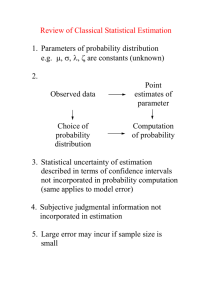
Bayesian Hierarchical Models for
Fitting Dose-Response Relationships
Ketra A. Schmitt
Battelle Memorial Institute
Mitchell J. Small and Kan Shao
Carnegie Mellon University
Dose Response Estimates using
Hierarchical Models
• Hierarchical Bayesian methods enable
simultaneous evaluation of
– multiple studies, evaluating
• different species
• sex
• biomarkers
– single studies
• Structuring hierarchies based on species, sex or measured
health endpoints (biomarkers)
– Hierarchies allow information to be shared between
parameter estimates
– Can be biologically informed
2
Advantages of Bayesian
Hierarchical Models
• Prior parameter distributions can chosen to be
“informationless” (yielding results similar to classical
methods) or “informed” to reflect some mechanistic
knowledge relative to the species, sexes, or endpoints
– Results using alternative informed priors can and should be
compared with each other and with informationless priors
– Able to more easily constrain parameters known to be nonnegative (or non-positive)
• Computational methods well established and readily
available (e.g., WINBUGS)
3
Options for Data Pooling
•
•
Allow us to treat data sets in complementary
ways
These also allow for comparison with bounding
assumptions in other approaches
–
•
Pooling data
Can compare results of models fit:
1. to each individual study;
2. hierarchically with parameters for each study (e.g.,
species, gender, or endpoint) sampled from a
parent distribution (including hyperparameters that
are also fit); or
3. with all data combined as if a single study
Æ The results in approaches 1-3 form a continuum
4
Previous HB work
• Preview of possible approach
• HB can also provide a format for
toxicologists and statisticians to develop
models together
5
Method
• Mechanistic Diagram
• Bayesian Hierarchical dose-response
model
– Implemented in Bayesian Inference Using
Gibbs (BUGS) software
– Markov Chain Monte Carlo (MCMC)
– Samples from posterior distribution
• Benchmark Dose (BMD)
– Multi-endpoint BMD
– BMDL
6
Mode of action framework for
(Perchlorate)
Exposure
Internal
Dose
Perchlorate
Exposure
Perchlorate
In blood
Biologically
Effective
Dose
Perchlorate
Inhibition of
Iodide Uptake
In Thyroid
Early
Biological
Effect
Altered
Structure/
Function
Effect on
Thyroid
Hormone
Altered
Development
7
Mechanistic Diagram
Dose
Thyroid
Level
Blood
Level
Decreased Production
of T3 & T4
Inhibition of
Iodine Uptake
Colloid
Depletion
Reduced
T3
T4
Levels
Increased
TSH
levels
Hyperplasia
Hypertrophy
8
Linked Model for Multiple Endpoints
(preliminary)
Dose
Colloid
Depletion
(CD)
T3
Hypertrophy
(HT)
TSH
T4
Hyperplasia
(HP)
Likelihood function:
⎛ T3 ⎞
f (CD | dose) f (⎜ ⎟ | dose) f (TSH | dose) f (HT | T4, dose) f (HP | HT occurred, T4, dose)
⎝ T4 ⎠
9
Hierarchy for sex and time point (day)
Hyperparameter
Common for
Day(14 and 90)
Hyperparameter
Common for
Sex in 14-day
Parameter
For
Female rats
In 14-day
Parameter
For
male rats
In 14-day
Hyperparameter
Common for
Sex in 90-day
Parameter
For
Female rats
In 90-day
Parameter
For
male rats
In 90-day
10
Potential Hierarchical Structures
– Data set 2 Frambozadrine: Different sex
• male and female rats
– Data set 3 Nectorine: Different endpoints
• respiratory epithelial adenoma and olfactory
epithelial neuroblastoma in rats
– Data set 4 Persimonate: Different studies
• same species, gender, and endpoint
11
Example of Possible Hierarchical Model for Data Set 2:
Frambozadrine with Male and Female Rats
1. Assume quantal-linear (simple exponential with background) model with:
Prob[Response] = B + (1-B) * [1-EXP(-S*D)] ;
where B is fitted background parameter and S is fitted slope parameter
2. Specify model:
For rat gender j; j = 1, 2
Bi ~ Beta (αB, βB)
where αB, βB are the hyperparameters for the global distribution of background
B across genders
Note: A beta distribution is chosen since B is constrained to (0, 1)
Si ~ Normal (µS, σS)
where µS, σS are the hyperparameters for the global distribution of slope S
across genders
3. Specify prior:
Vague αB, βB : flat on the range (1, infinity) (If parameters = 1, represents
U(0,1) prior for the Bj
Vague µS, N(0, large); and vague σS , Gamma(1, 1)
12
Multiple Endpoints: Prob[one or other]
Data set 3 Nectorine:
E1 = respiratory epithelial adenoma
E2 = olfactory epithelial neuroblastoma
Pr[E1 or E2] = Pr[E1] + Pr[E2] – Pr[E1 and E2]
If E1 and E2 truly independent, Pr[E1 and E2] = Pr[E1]*Pr[E2]
Can then compare this result to alternative assumptions
regarding dependency, e.g., Pr[E2|E1] = γ * Pr[E2|not E1],
where γ ranges from 1 to 10.
(Of course would help to have the different endpoints measured on
the same test animals!)
13
Data Set 1 Parameter Estimates
(Exponential Model: Pr[R] = B + (1-B) * [1-EXP(-S*D)] )
Parameter
Estimate
(Std. Err.)
Classical
(EPA BMDS):
Bayesian
(WINBUGS):
BMD5
BMD10
B
S
Parameter
Correlation
Coefficient
MLE
LCL95
MLE
LCL95
0.025
(0.0243)
0.011
(0.0022)
-0.33
4.6
3.4
9.5
7.0
0.037
(0.03)
0.010
(0.0023)
-0.41
4.7
3.4
9.6
7.0
14
Data Set 2 Parameter Estimates
(Exponential Model: Pr[R] = B + (1-B) * [1-EXP(-S*D)] )
Parameter Estimate
(Std. Err.)
B
S
BMD5
BMD10
Par.
Corr.
MLE
LCL95
MLE
LCL95
Dataset 2 (Male Only)
Classical (EPA BMDS):
0.068
(0.0249)
0.007
((0.0017)
-0.3
7.8
5.8
16.1
11.0
Dataset 2 (Male Only)
Bayesian (WINBUGS):
0.072
(0.025)
0.0073
(0.0017)
-0.26
7.1
4.8
15
9.9
Dataset 2 (Female Only)
Classical (EPA
BMDS):
0.0569
(0.022)
0.0082
(0.0016)
-0.23
6.7
4.9
13.7
10.1
Dataset 2 (Female Only)
Bayesian (WINBUGS):
0.027
(0.031)
0.0088
(0.0014)
-0.39
5.8
4.6
11.9
9.5
0.047
(0.019)
0.0080
(0.0014)
-0.56
6.4
4.4
13.1
9
Dataset 2 (Both)
Bayesian (WINBUGS):
15
5
2
1
Dose
10
20
Distribution of BMDs
.101
.052
BMR
3
.01
16



